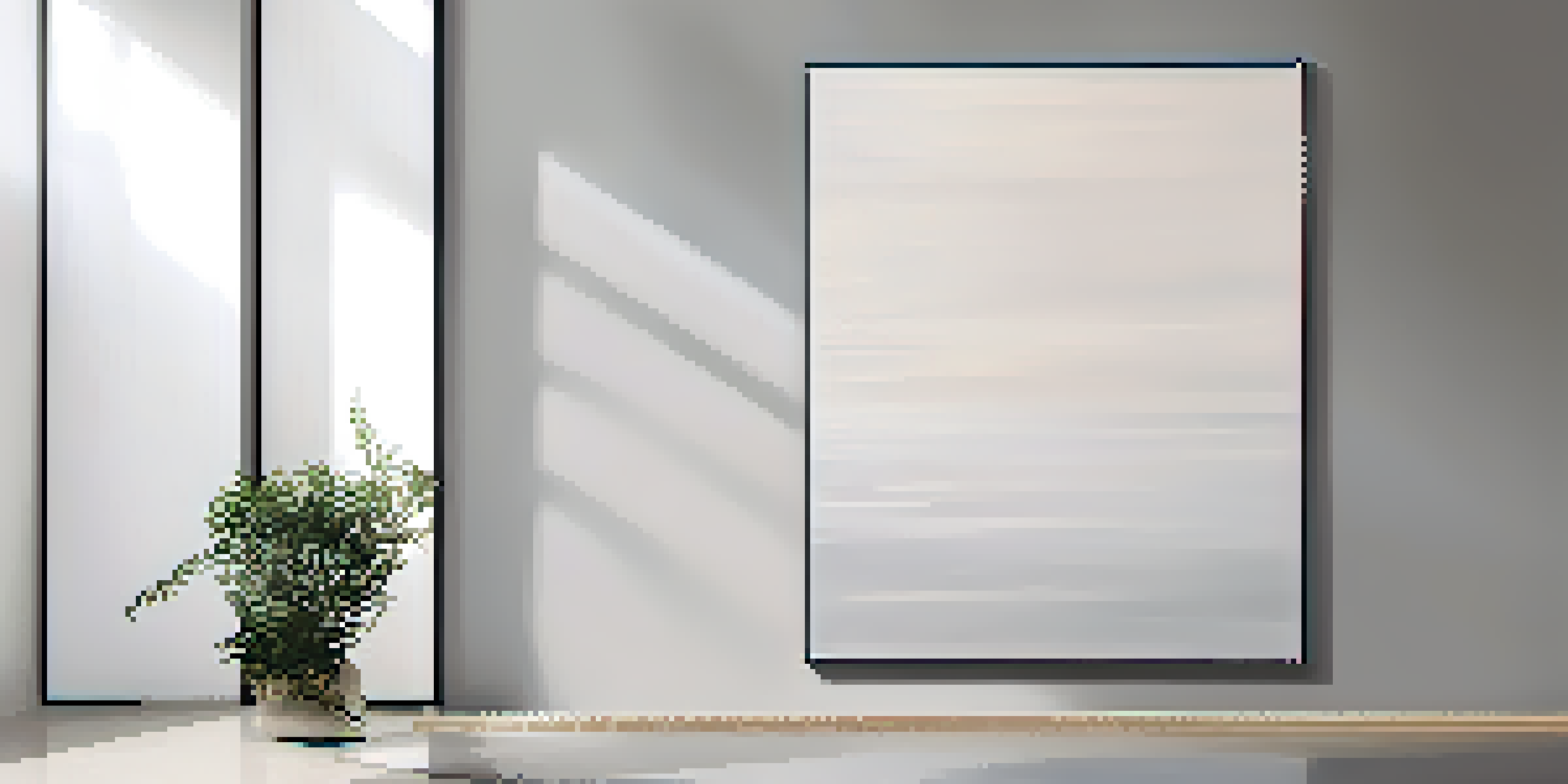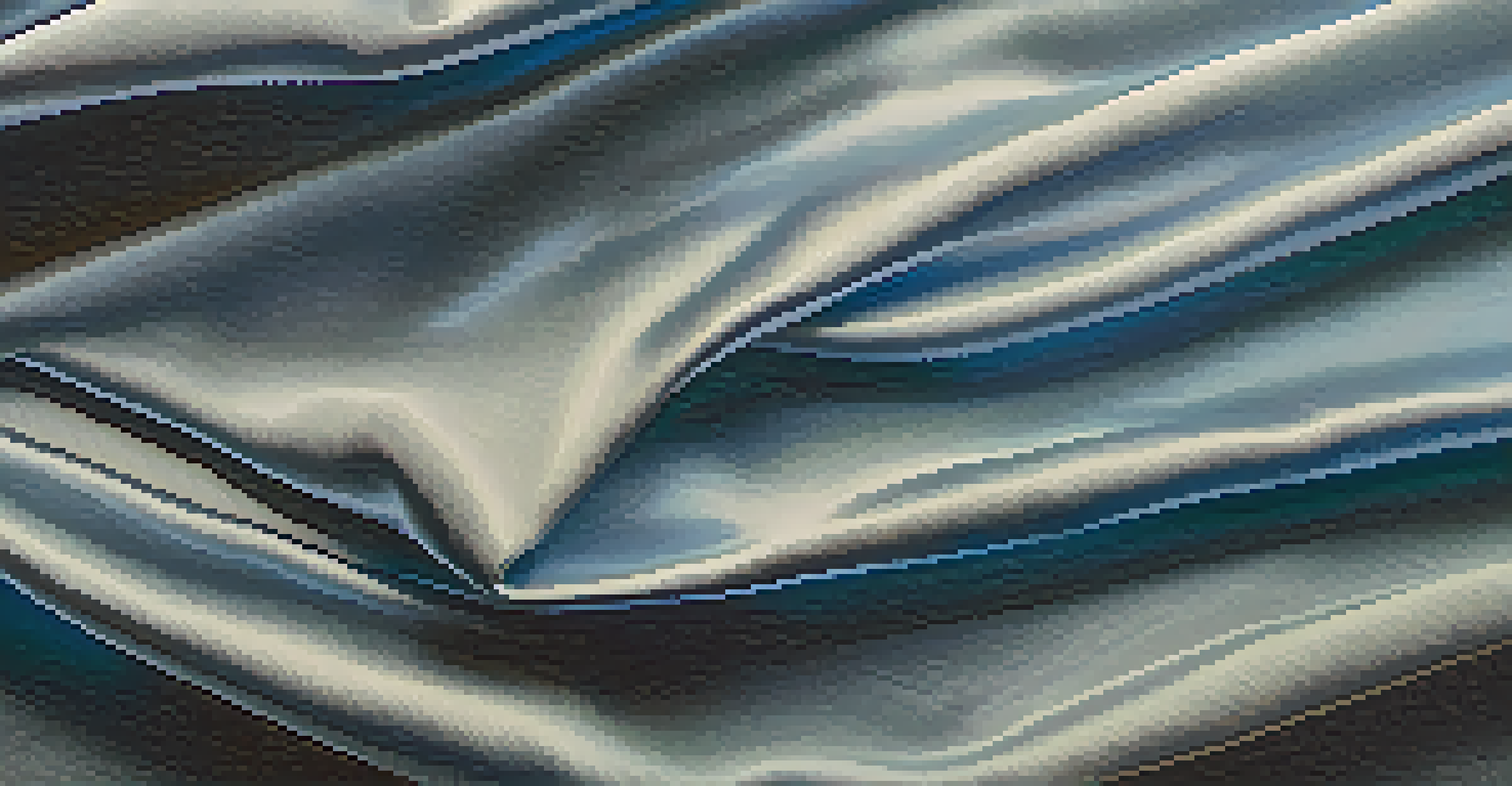The Significance of Texture in Minimalist Artworks

Understanding Minimalism and Texture
Minimalism in art is about stripping down to the essentials, focusing on simplicity and clarity. Yet, within this simplicity lies the intriguing element of texture, which can evoke emotions and create depth. Texture, in this context, refers to the surface quality of an artwork, whether it's smooth, rough, soft, or hard. It invites viewers to engage not just visually but also tactilely, even if they can't physically touch the piece.
Simplicity is the ultimate sophistication.
In minimalist art, the use of texture can turn a seemingly plain canvas into a rich experience. For instance, a monochromatic surface may appear simple at first glance, but the subtle variations in texture can reveal a complex narrative. Artists often use different materials to create varied textures, leading the viewer to explore the piece from multiple angles and perspectives.
This interplay of texture and minimalism creates a dialogue between the artwork and the observer. As viewers engage with these textures, they may find themselves reflecting on their own experiences and emotions, deepening their connection to the piece. Thus, understanding texture becomes pivotal in appreciating minimalist artworks.
The Role of Materiality in Minimalist Textures
Materiality is a significant aspect of texture in minimalist art. The choice of materials—such as wood, metal, or fabric—can dramatically affect how a piece is perceived. For example, a sleek metal surface may convey a sense of modernity and precision, while a rough wooden texture might evoke warmth and nostalgia. These material choices amplify the artwork's message and impact.

Moreover, artists often manipulate materials to enhance their textural qualities. Techniques like layering, sanding, or painting can transform the surface of an artwork, adding depth and intrigue. This thoughtful manipulation encourages viewers to appreciate the craftsmanship behind the piece, reminding them that even minimalism requires skill and intention.
Texture Enhances Minimalist Art
The interplay of texture within minimalist artworks transforms simple pieces into rich, engaging experiences.
In this sense, the materiality of minimalist artworks is not merely functional; it's an integral part of the aesthetic experience. As observers engage with the various materials used, they uncover layers of meaning that might not be immediately apparent. This connection between materiality and texture enriches the overall narrative of the artwork.
Texture's Emotional Resonance in Art
Texture has a unique ability to evoke emotions, making it a powerful tool in minimalist art. Different textures can elicit varying feelings, from tranquility to tension. For example, a smooth, polished surface may instill a sense of calm, while jagged, rough textures might provoke discomfort or unease. This emotional resonance invites viewers to explore their feelings as they interact with the artwork.
The details are not the details. They make the design.
Artists often use texture strategically to convey their intended message or theme. By juxtaposing contrasting textures, they can create visual tension that speaks to the complexities of human experience. This method encourages viewers to reflect on their own emotional responses, transforming the act of viewing into a personal journey.
Ultimately, the emotional impact of texture in minimalist art can transform a simple visual experience into a profound exploration of feelings. By engaging with these textures, viewers embark on a deeper connection with the artwork, making it a memorable part of their artistic journey.
The Interaction Between Light and Texture
Light plays a crucial role in how texture is perceived in minimalist artworks. The way light interacts with different surfaces can dramatically alter their appearance and the viewer's experience. For instance, a textured surface may cast shadows that highlight its contours, adding depth and complexity to an otherwise simple piece. This dynamic relationship encourages viewers to explore the artwork from various angles.
Artists often consider light when designing their minimalist pieces, strategically placing them in environments where natural or artificial light enhances their textural qualities. This thoughtful placement can create an ever-changing visual experience, as the artwork transforms with the shifting light throughout the day. Such interactions invite observers to return, discovering new layers and meanings with each visit.
Materiality Shapes Artistic Perception
The choice of materials in minimalist art significantly influences how viewers perceive and emotionally connect with the work.
By understanding the relationship between light and texture, viewers can deepen their appreciation for minimalist artworks. This awareness enriches the experience, transforming a static observation into a dynamic exploration of form, light, and texture.
Texture as a Tool for Visual Balance
In minimalist art, achieving visual balance is essential, and texture plays a key role in this aspect. By incorporating various textures, artists can guide the viewer's eye across the composition, creating a sense of harmony. For example, a heavily textured area may be balanced by a smoother, calmer section, allowing the viewer to experience the entire piece more cohesively.
This balance is not only about aesthetics; it also influences how the viewer emotionally engages with the artwork. A well-balanced composition can evoke feelings of serenity and satisfaction, while an unbalanced one might create tension or unease. The use of texture, therefore, becomes a method for artists to control the emotional landscape of their work.
Ultimately, the interplay of texture and visual balance enriches the minimalist aesthetic, proving that even simplicity can be complex. Viewers are invited to explore these nuances, resulting in a more profound appreciation of the artist's intention.
The Influence of Cultural Context on Texture
Cultural context significantly influences how texture is perceived in minimalist art. Different cultures have unique traditions and materials that shape their artistic expressions. For example, Japanese minimalism often incorporates natural materials like bamboo and paper, emphasizing a connection to nature through texture. This cultural lens invites viewers to reflect on their backgrounds and experiences as they engage with the artwork.
Furthermore, artists may draw inspiration from their cultural heritage, infusing their works with textures that resonate with their identity. This intentionality not only enhances the visual experience but also creates a narrative that speaks to broader themes of culture and belonging. As viewers explore these textures, they may find themselves connecting with unfamiliar yet relatable cultural stories.
Cultural Context Influences Texture
Different cultural backgrounds impact the textures used in minimalist art, creating deeper narratives and connections for viewers.
Understanding the cultural significance of texture in minimalist art enriches the viewer's experience and appreciation. It allows for a deeper exploration of the interconnectedness of art, identity, and culture, transforming the act of viewing into a shared journey.
Conclusion: Embracing Texture in Minimalism
In conclusion, texture holds immense significance in minimalist artworks, transforming them from simple to complex experiences. It invites viewers to engage on multiple levels, from emotional resonance to cultural reflection. As we explore the interplay of texture within minimalism, we uncover rich narratives that can be easily overlooked in more traditional forms of art.
By embracing the importance of texture, both artists and viewers can deepen their connection to minimalist works. This exploration encourages a more mindful approach to art, where every element, even those that seem minimal, can carry profound meaning. The beauty of minimalist art lies in its ability to evoke thought and emotion through simplicity and texture.

Ultimately, the significance of texture in minimalist artworks reminds us that even in simplicity, there is depth. As we continue to engage with these pieces, we discover that texture is not just an aesthetic choice; it's a gateway to understanding the broader human experience.